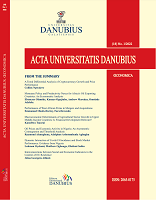Investigating the Fisher’s Effect in Uganda: Evidence from ARDL Model
Investigating the Fisher’s Effect in Uganda: Evidence from ARDL Model
Author(s): Mbongeni Zwelakhe Ngubane, Kehinde Damilola IlesamniSubject(s): National Economy, Economic policy, Economic development
Published by: Editura Universitară Danubius
Keywords: Fisher’s effect; interest rates; Granger Causality;
Summary/Abstract: Given that no other study has conducted the same empirical work in Uganda, the study examined Fisher’s (1930) effect in this particular country. While inflation and the money supply served as the explanatory variables, the nominal interest rates served as the dependent variable. Through the use of data collected between 2011M7 and 2021M3, the ARDL model was employed in the study. The results showed that nominal interest rates indeed, in the long term, respond to predicted inflation rates on a one to-one basis, with positive and statistically significant results. This indicates that Uganda is where Fisher’s effect is strongest. These findings demonstrate the validity of inflation targeting and make it easier for economic agents to predict inflation and the nominal interest rate. Granger causality, which has a unidirectional causality extending from inflation to nominal interest rates, likewise confirmed the same findings. The paper suggests that Uganda’s monetary policymakers shift to a full-fledged inflation targeting regime at the second level of inflation targeting to anchor the commercial agents that will produce the highest amount of investment-driven growth.
Journal: Acta Universitatis Danubius. Œconomica
- Issue Year: 19/2023
- Issue No: 2
- Page Range: 76-90
- Page Count: 15
- Language: English

